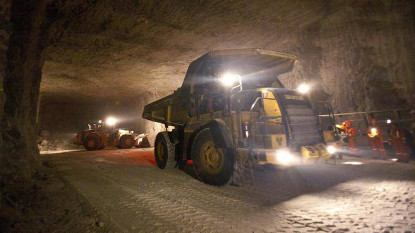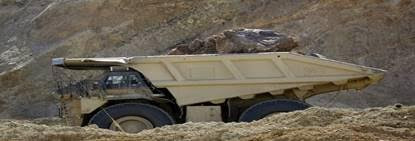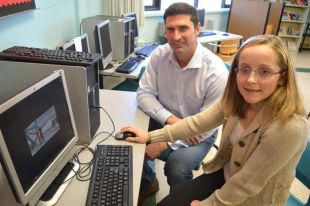Media - 2016 Archive
Cape Bretoners among judges for mining video entries
Published: June 16, 2016
Source: Cape Breton Post
SYDNEY, N.S. — Two Cape Bretoners have been added to the judging panel for this year’s Mining Association of Nova Scotia ‘Mining Rocks!’ video contest.
Membertou Chief Terry Paul and Victoria County Warden Bruce Morrison will be among 12 judges for the contest that encourages youth in the province to produce short videos about mining and quarrying.
“I am very pleased to be a judge for the video contest and to work in partnership with the mining association on educating students about the industry,” said Paul, in a press release.
“We all want to create more opportunities and a brighter future for our children and the video contest is a good way to teach them about mining.”
Other judges included Lloyd Hines, the Minister of Natural Resources, and Martha Cooley, executive director of the Atlantic Filmmaker Cooperative.
“We are delighted to have such an impressive and diverse group of people serving as judges in this year’s contest,” said Sean Kirby, executive director of the mining association, in a press release.
“We really hope students will take advantage of this opportunity to learn about mining and put their creative efforts before this accomplished panel.”
The contest — open to all junior high and high school students in Nova Scotia — determines winners in five different categories.
January 13 is the early bird contest deadline and students who submit entries by that date could win one of two $250 prizes.
The final deadline for entries is Feb. 28.
Go online to www.NotYourGrandfathersMining.ca/contest for more contest information.
Mine safety criticism unfounded
Published: June 16, 2016
Source: Cape Breton Post
I am writing in response to an article about Davis Day which raised questions about the mining industry’s safety record (“Union leader puts Donkin mine owner in Davis Day spotlight, June 13, Cape Breton Post).
As an industry, we believe the most important thing to come out of a mine is the miner, and our modern safety record reflects this. Injury rates in Nova Scotia's mining and quarrying industry have been reduced 90 per cent in the past two decades, making mining one of the safest industries in Nova Scotia today. We are committed to continuous improvement in mine and quarry safety – and to making sure a tragedy like Westray never happens again.
Nova Scotia's mining and quarrying industry employs 5,500 Nova Scotians, mostly in rural areas, and it is great news for Cape Breton that the Donkin coal mine will create 135 more jobs.
Just as we would not judge today’s auto industry by its safety and environmental standards from a half-century ago, we also should not judge today’s mining industry by outdated perceptions. Visit www.NotYourGrandfathersMining.ca to learn more.
Broken tax pledge irks N.S. mining industry
Published: April 21, 2016
Source: The Chronicle Herald
http://thechronicleherald.ca/business/1358651-broken-tax-pledge-irks-n…
 An oversized dump truck carries a load of salt from its excavation point in the Canadian Salt Company mine, about 1,000 feet beneath Pugwash. The Mining Association of Nova Scotia is less than pleased that the McNeil government has omitted a 2014 promise to created a fuel tax rebate for some vehicles used in mining for the second budget in a row. (Photo: The Chronicle Herald Staff)
An oversized dump truck carries a load of salt from its excavation point in the Canadian Salt Company mine, about 1,000 feet beneath Pugwash. The Mining Association of Nova Scotia is less than pleased that the McNeil government has omitted a 2014 promise to created a fuel tax rebate for some vehicles used in mining for the second budget in a row. (Photo: The Chronicle Herald Staff) The province now has two strikes against it in the eyes of Nova Scotia’s mining companies.
This week’s budget marked the second straight year the McNeil government has broken a promise to the $420-million mining and quarrying industry, says the Mining Association of Nova Scotia.
In May 2014, then-Finance Minister Diana Whalen wrote to MANS executive director Sean Kirby, describing the industry as “critical to the success” of Nova Scotia’s economy and assuring MANS the government would fulfil during the final three years of its current term its election promise to phase in a fuel tax rebate for off-road vehicles used in mining and quarrying operations. In November 2015, then-Natural Resources Minister Zach Churchill promised the industry would start receiving the rebate in 2015. However, the government’s 2015 budget did not make the change and this week Finance Minister Randy Delorey’s budget omitted it.
“The government’s promise to support the industry and help us create jobs, particularly in rural areas, was clear and unequivocal. But it has not made good on it,” Kirby told the Chronicle Herald.
“Today’s annual general meeting (of MANS) will be a somewhat grumpy gathering, given the rebate issue.”
He added that the government gives other resource industries a tax rebate for fuel used in vehicles that do not go on public roads, such as fishing boats, farm tractors and forestry harvesters.”
Department of Finance spokesperson Marla MacInnis said the government’s first priority was “getting the province back to sustainable finances so that we can make smart investments in our people and economy.”
“We haven’t forgotten our commitment to the mining industry to remove the tax. We will continue our conversations with industry and when the province is in a sustainable fiscal position this is something that can and will be considered,” she told the Chronicle Herald.
In a statement via email, Department of Natural Resources Minister Lloyd Hines said the government was “totally committed” to Nova Scotia’s mining industry.
“When the time and our fiscal capacity is there and it is clear that we can do this, we will do it,” Hines said.
“We fully intend to give the request from the industry, with regard to fuel tax, our full consideration.”
Kirby said the industry, which he said employs 5,500 people, faces significant challenges including a reputation as a poor place to invest. The rebate would save the industry $2.6 million annually.
He said that according to 2013 government-commissioned research, Nova Scotia’s mining and quarrying industry lost approximately 800 jobs in the previous five years, while its economic output shrank by $80 million per year.
Nova Scotia Mineral Resources Act has support of mining lobby group
Law amendments committee heard from environment groups, industry stakeholders on Monday
By: David Irish
Published: Apr 26, 2016
Source: CBC News

Nova Scotia's minister of natural resources and a mining industry lobby group say changes coming to the Mineral Resources Act are meant to modernize a law that hasn't been changed in 25 years and strike a balance between economy and environment.
Nova Scotia's law amendments committee met on Monday morning to listen to public feedback about Bill 149 — an overhaul of the act that regulates mineral resource management in the province.
For Sean Kirby, executive director of the Mining Association of Nova Scotia — the industry's main lobby group — the overhaul is welcomed.
"To us, it's really just about balance. Every time we remove land from economic usage in the province, we're making it harder for industries like ours to create jobs for Nova Scotians," Kirby said.
Not the bill for environmental concerns
 Natural Resources Minister Lloyd Hines introduced Bill 149, which will overhaul the Mineral Resources Act which was last updated in 1990. (Province of Nova Scotia)
Natural Resources Minister Lloyd Hines introduced Bill 149, which will overhaul the Mineral Resources Act which was last updated in 1990. (Province of Nova Scotia)Environmental groups said at the meeting the bill doesn't go far enough to protect privately protected lands and doesn't address quarry production.
But Natural Resources Minister Lloyd Hines, who introduced the bill, said the focus needs to be about mineral resources and less about environmental impacts. The overhaul already overlaps enough with "very robust" environmental legislation that covers those concerns, he said.
"Much of the stuff that we're doing is aimed at streamlining the process, to reduce red tape, to essentially get rid of some of the cumbersome things in the 80s," Hines said.
That streamlining includes going from annual mineral licence renewals to doing renewals every two years, Kirby said. A new focus on public consultation introduced in the bill is also supported.
"We believe that all former mines need to be fully and properly reclaimed and that the cost of it has to be borne by the mining companies and the taxpayers should never be on the hook for reclamation," Kirby said.
Issue of quarries
 Sean Kirby is the executive director of the Mining Association of Nova Scotia. (CBC)
Sean Kirby is the executive director of the Mining Association of Nova Scotia. (CBC)Mining exploration licences and leases are given out to companies and prospectors by the Natural Resources Department. A mine can't advance until after a lengthy environmental assessment.
The Sierra Club Canada Foundation wants quarries included in the Mineral Resources Act.
Though a technical difference, crushed rock and sand is very different from the minerals regulated in the act, Kirby said, and legislation should be kept separate.
Under current legislation, quarries are a matter for the Environment Department.
To shift that from one department's legislation to another wouldn't be worth it because "it just isn't how it ever has been regulated in this province," Kirby said.
Hines said the act should remain about exploration.
"It is possible for an exploration to include private land," Hines said. "Unless you consented, there's no work that can be done on the private land."
The act also gives the minister of natural resources the ability to withdraw mineral rights and to decline exploration licences.
LOCAL YOUTH ON WHY MINING ROCKS!
By: Ben Cousins
Published: April 18, 2016
Source: Halifax Citizen
More than a few Halifax-area students have heavier wallets because of their newfound expertise with making videos about mining.
Four high school and middle school students from the Halifax Regional Municipality took home prizes in the Mining ROCKS! Video Contest, presented by the Mining Association of Nova Scotia.
“The videos are excellent,” said Sean Kirby, executive director of the Mining Association of Nova Scotia. “It’s really a fun thing to give students the opportunity to do this and not tell them what (the video) needs to be about, apart from mining.”
“It’s a great learning experience for them and from the look of the videos it looks like they’re having a lot of fun.”
Meagan Brown from Charles P. Allen High School and Jasmine Metzler from Sackville Heights Junior High School each took home $1,000 for their videos.
Brown’s video won for “Best High School Video” and features little-known facts about the mining industry in Nova Scotia and Nova Scotian companies that produce materials for everyday items.
Levi Marshall from Sackville High School was the biggest winner of the day, winning a first-place prize in the “Best Comedy” category and runner-up in the “Best 30-second commercial category for two separate videos. Both prizes netted Marshall a total of $1,500.
Jonah Larsen from Citadel High School won second place in the “People’s Choice” award, winning $500.
“The stuff the kids came up with was incredibly clever and creative and really showing off their technical skills,” said Kirby. “It’s a really fun and exciting contest for us.”
The contest’s panel of judges included Lloyd Hines, minister of Natural Resources, Membertou Chief Terry Paul, as well as film and media professionals. The contest awarded $8,000 in prize money for students across the province.
“(The videos are) just absolutely outstanding,” said Hines. “There was a lot of talent (involved).”
“(The contest) involves the young people, and that’s who we need to educate about the mining industries in Nova Scotia.”
Hines said he was looking for videos that showed the importance of minerals for young people, including the minerals in smartphones and other everyday items.
In total, 22 teams of students submitted videos to the contest. There were 1848 votes for the People’s Choice Award.
Kirby said this is part of a broader initiative to educate the public on the importance of mining to the economy and to dispel some of the misconceptions about the industry.
“We have to do a better job correcting that and explaining to people that the industry today is really a very sophisticated, modern, and high tech industry that operates at the highest standards.”
According to the Mining Association of Nova Scotia, the mining and quarrying industry in this province is a key creator of jobs and prosperity for Nova Scotians, providing nearly 5,500 jobs, mostly in rural areas.
The industry also contributes $420 million to the province’s economy each year.
To watch all the winning videos, visit: http://notyourgrandfathersmining.ca/2016-winners.
Video contest fosters mining awareness among Nova Scotian students
By: Greg Klein
Published: April 11, 2016
Okay, there was a cash incentive. But the enthusiasm’s genuine. The Mining Association of Nova Scotia asked high school students to research a brief topic on mining and quarrying, then find a way to portray it on video. The results were not only informative but inventive and entertaining. And they brought contest winners a total of $8,000 in prizes, MANS announced April 11.
Now in its second year, Mining ROCKS! pulled in 22 entries from students across the province. Judges included film and media pros as well as Minister of Natural Resources Lloyd Hines and Membertou Chief Terry Paul, among others. Another 1,848 people cast votes for the People’s Choice Award.
The winners (shown here) use wide-ranging approaches to explain, illustrate, dramatize and emphasize the many uses of minerals and the industry’s importance to Nova Scotia. This is, after all, a province where coal mining dates back to 1672—and coal’s a relative newcomer. MANS says Canada’s oldest mine, possibly North America’s oldest, would be Davidson Cove, where Mi’kmaq extracted jasper and agate for arrowheads and cutting tools 1,500 years ago.
Mining and quarrying now provide around 5,500 jobs and put $420 million into the provincial economy each year.
As for the Ontario Mining Association, it now has judging underway for its student video contest, So You Think You Know Mining. Winners will be announced June 1.
See the winning entries for Mining ROCKS!
This article was posted by Greg Klein - Resource Clips on Monday, April 11th, 2016 at 5:42 pm.
http://resourceclips.com/2016/04/11/mining-rocks-video-contest-gets-nov…
Glace Bay High School student claims mining contest award
By: Sharon Montgomery-Dupe
Published: April 11, 2016
GLACE BAY - The people have spoken.
 © Sharon Montgomery-Dupe/Cape Breton Post video
© Sharon Montgomery-Dupe/Cape Breton Post videoBryah Boutilier, a Grade 10 student at Glace Bay High School, received a $1,000 cash prize and the people's choice award for her 30-second video "Mining For Our Future," in the Mining Association of Nova Scotia contest, Mining Rocks.
Boutilier said she was "overly excited" when she heard the news.
"I had no idea I was going to win."
And finding out it was a people's choice award made it even better.
She immediately told her grandfather Dave Boutilier, a former miner, who is featured in her video.
"He was very proud of me."
The Mining Rocks video contest was open to all junior high and high school students in Nova Scotia. Students were asked to produce a short video about mining and quarrying.
The contest received 22 video contributions from Nova Scotia students. There were 1,848 votes for the people's choice award.
The video includes old photos from coal mines and a short interview with her grandfather.
Boutilier also won $500 in an early bird draw. The video was chosen by random draw from the videos submitted by the Jan. 15 early bird deadline.
In an earlier story in the Cape Breton Post, Boutilier said she first heard about the contest in her science class. With family roots in the mining industry, including both grandfathers – Dave Boutilier and the late Bennie Benoit – she knew she had lots of pictures and other material for a video.
She said her focus for the video was to promote mining to the younger generation.
Minister of Transportation and Infrastructure Renewal Geoff MacLellan was at Glace Bay High School Monday to present Boutilier with the cheque for $1,000 on behalf of the mining association.
MacLellan, who is also the MLA for Glace Bay, said he watched the video and enjoyed it.
"It certainly represents our past and everything that mining has done for us," he said.
He described Boutilier's grandfather Dave Boutilier as a true gentleman.
"I know he'd be very proud of his granddaughter Bryah for really celebrating who and what we are.
"The fact people have recognized the value of this video and rewarded Bryah as such is a great thing," he said. "We want to spread that word to our young people here in Glace Bay and in Cape Breton Island about what mining has meant."
In a press release, Sean Kirby, executive director of the mining association, said students from across the province created incredibly clever and interesting videos about mining and quarrying.
“We congratulate all the students for their excellent work and thank them for participating in the contest," said Kirby.
Natural Resources Minister Lloyd Hines and Membertou Chief Terry Paul were contest judges along with film and media professionals.
Go to http://notyourgrandfathersmining.ca/2016-winners to view all of the videos.
Student wins $500 in contest
By: Sharon Montgomery-Dupe
Published: January 24, 2016
GLACE BAY - The Mining Association of Nova Scotia (MANS) awarded $500 to a Glace Bay High School student Friday when she won the “early bird” draw for the Mining ROCKS! video contest.
 © Sharon Montgomery-Dupe - Cape Breton Post. Nova Scotia Minister of Transportation and Infrastructural Renewal Geoff MacLellan presents a cheque for $500 to Glace Bay High School student Bryah Boutilier, an early bird prize in a Mining Association of Nova Scotia contest.
© Sharon Montgomery-Dupe - Cape Breton Post. Nova Scotia Minister of Transportation and Infrastructural Renewal Geoff MacLellan presents a cheque for $500 to Glace Bay High School student Bryah Boutilier, an early bird prize in a Mining Association of Nova Scotia contest.Bryah Boutilier, a Grade 10 student of GBHS, was presented $500 as a result of her video, “Mining for our Future."
The video was chosen by random draw from the videos submitted by the Jan. 15 early bird deadline.
"I am so happy," she said.
"I can't believe I won the early bird prize."
Boutilier said she first heard about the contest in her Science class. She said with family in mining - including her grandfathers Dave Boutilier and the late Bennie Benoit - she knew she had lots of pictures and other material for a video.
She said coal mining has helped support past families so why couldn't it support families in the future?
"I did all coal mining pictures promoting mining for the young generation."
Boutilier said she plans to spend this prize money when she goes to Disney World in March with the high school band.
The Mining Rocks Video Contest is open to all junior high and high school students in Nova Scotia. Students were asked to produce a short video about mining and quarrying. Sean Kirby, executive director of MANS, said they wanted students to have fun with it and to be creative.
MLA Geoff MacLellan presented the check to Boutilier on MANS’ behalf, Friday.
"It was a great opportunity for a Glace Bay student to send in a submission about our local heritage, it's a great tie in to our mining past with her grandfather and the future that holds in store with Donkin mine."
MacLellan said he encourages students to take part. He said it's great for any young student and young adults in the local area to understand our mining heritage and how it's shaped our future to where we are today.
He said it's important history to hang on to.
"It's great to have young people who weren’t around when the mines were up and running to understand the engine that drove the local economy and kept families fed and looked after," he said.
"I think it’s a good contest to get word out there and have students doing research on their local area and the impact mining has had on our past, our present and certainly in the future."
MacLellan said he has lots of interest and communication with MANS.
He said he is interested in all the mines in Nova Scotia.
"Now with Donkin progressing in the right direction, we've had continuing conversations with MANS to keep in touch with what's going on there."
The final deadline for video entries is February 26. The winners in five different categories will be awarded $1000, with $500 going to the runner-ups.
The judging panel includes Lloyd Hines, Minister of Natural Resources, Membertou Chief Terry Paul, as well as several accomplished film and media professionals.
For more information, go to http://NotYourGrandfathersMining.ca/contest
allNovaScotia.com
By: Sean Kirby, executive director, Mining Association of Nova Scotia (www.NotYourGrandfathersMining.ca)
Published: January 22, 2016
I am writing in response to Kevin Cox’s column, “Moral Mining.”
Nova Scotia’s mining industry believes the most important thing to come out of a mine is the miner, and our safety record reflects this. Injury rates in the mining and quarrying industry have been reduced 90% since the Westray public inquiry report was released in 1997, and are now lower than other comparable Nova Scotia industries. Today, mining is one of the safest industries in the province.
The mining and quarrying industry is regulated by Nova Scotia’s Occupational Health and Safety Act, which sets stringent standards for workplace safety, provides for government inspections to ensure compliance, and penalties/fine for infractions. We work every day, in partnership with the provincial government, to make our workplaces safer for our colleagues, friends and loved ones.
Not Your Grandfather’s Coal Mine
By: Sean Kirby, executive director, Mining Association of Nova Scotia (www.NotYourGrandfathersMining.ca)
Published: January 22, 2016
I am writing to respond to recent articles and letters about the opening of the Donkin coal mine.
Mining has played an important role in the development of Cape Breton through the years. Nova Scotia coal was first mined in Sydney in 1672 and the first commercial coal mining venture in Canada was established by the French in 1720 in Cow Bay, Cape Breton, to supply the Fortress of Louisbourg.
This long history also underscores how different today’s mining industry is from the past. Mining today is a safe, environmentally-responsible industry that is essential to our modern way of life. The materials we mine make possible virtually everything in our daily lives, from homes, schools and hospitals to electronics to safe, ice-free roads.
We have reduced our injury rate by 90% in the past two decades, making mining one of the safest industries in Nova Scotia.
We set the highest standards for environmental management and protection. Reclaimed mines and quarries are now beautiful natural spaces throughout the province. They are also used for other purposes such as Cabot Links, which is both a beautiful, world-class golf course and an important economic anchor for the Inverness area.
Coal is an essential fuel in Nova Scotia, and in most jurisdictions around the world. It generates approximately 60 percent of Nova Scotia’s electricity and is also used in manufacturing vital products such as steel and cement. While Nova Scotia’s use of coal is declining, the electricity it provides cannot be replaced easily or quickly by any other source. Coal plays a major role in keeping our lights on, and in powering places like hospitals and schools.
Mining coal here, instead of importing most of it as we do now, makes it less expensive and helps keep our energy bills down. It reduces the overall environmental footprint of the coal we use by eliminating the need to ship it from South America. It creates jobs and much-needed economic activity for the province – Donkin will create about 120 jobs in Cape Breton, adding to the 5500 Nova Scotians the mining industry already employs.
Just as we would not judge today’s auto industry by its safety and environmental standards from a half-century ago, we also should not judge today’s mining industry by outdated perceptions. Visit www.NotYourGrandfathersMining.ca to learn more.
Sean Kirby is Executive Director of the Mining Association of Nova Scotia
Donkin Redux Makes Sense
By: Sean Kirby, executive director, Mining Association of Nova Scotia (www.NotYourGrandfathersMining.ca)
Published: Jan 18, 2016
I am writing to respond to recent articles and letters about the opening of the Donkin coal mine. Today’s mining industry is a safe, environmentally responsible industry that is essential to our modern way of life. The materials we mine make possible virtually everything in our daily lives, from homes, schools and hospitals to electronics and safe, ice-free roads. We have reduced our injury rate by 90 per cent in the past two decades, making mining one of the safest industries in Nova Scotia.
 Opening the Donkin coal mine in Cape Breton makes sense because the province won’t need to import the fuel, writes Sean Kirby, executive director of the Mining Association of Nova Scotia. (Staff)
Opening the Donkin coal mine in Cape Breton makes sense because the province won’t need to import the fuel, writes Sean Kirby, executive director of the Mining Association of Nova Scotia. (Staff)We set the highest standards for environmental management and protection. Reclaimed mines and quarries are now beautiful natural spaces such as Acadia Park in Westville, Kiwanis Park in Truro and Point Pleasant Park in Halifax. They are also used for other purposes such as Cabot Links golf course in Inverness, the Pioneer Coal Athletics Field in Stellarton and the Dartmouth Crossing shopping centre.
Coal is an essential fuel in Nova Scotia, and in most jurisdictions around the world. It generates approximately 60 per cent of Nova Scotia’s electricity and is also used in manufacturing vital products such as steel and cement. While Nova Scotia’s use of coal is declining, the electricity it provides cannot be replaced easily or quickly by any other source. Coal plays a major role in keeping our lights on and in powering places like hospitals and schools.
Mining coal here, instead of importing most of it as we do now, makes it less expensive and helps keep our energy bills down. It reduces the overall environmental footprint of the coal we use by eliminating the need to ship it from South America. It creates jobs and much-needed economic activity for the province. Donkin will create about 120 jobs, adding to the 5,500 Nova Scotians the mining industry already employs. Just as we would not judge today’s auto industry by its safety and environmental standards from a half-century ago, we also should not judge today’s mining industry by outdated perceptions.



